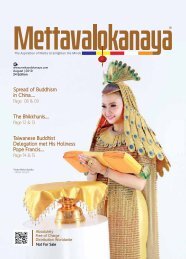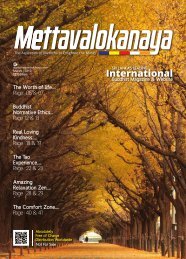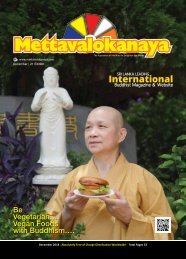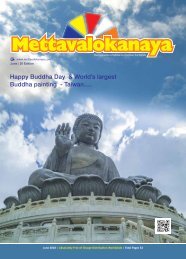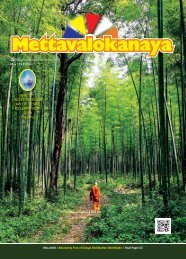#Mettavalokanaya_International_Buddhist_Magazine_May_2021
This is the World’s Most Popular & Leading Monthly International Buddhist Magazine, “Mettavalokanaya” on May 2021 Vesak Edition - 31. https://mettavalokanaya.com/magazine-31/ http://www.mettavalokanaya.com/
This is the World’s Most Popular & Leading Monthly International Buddhist Magazine, “Mettavalokanaya” on May 2021 Vesak Edition - 31.
https://mettavalokanaya.com/magazine-31/
http://www.mettavalokanaya.com/
You also want an ePaper? Increase the reach of your titles
YUMPU automatically turns print PDFs into web optimized ePapers that Google loves.
The
Mindfulness….
Mind and
Evaluating
Most Venerable Ajahn
Sucitto Maha Thera
Cittaviveka (Chithurst Buddhist
Monastery), Chithurst, Petersfield,
Hampshire, United Kingdom.
Mindfulness of in- and outbreathing
is the most
detailed and progressive
meditation instruction
given by the Buddha, affirmed by
him as being a practice that leads
to full Awakening. In the sutta in
which these teachings are recorded
[M.118], the instructions are laid
out in four groups (called ‘tetrads’).
These tetrads comprise groups of
progressive instructions with regard
to mindfulness of breathing as it
affects and moderates the bodily
energies, mental (emotional and
psychological) energies and mental
awareness. The fourth tetrad has a
different approach, as we will see
in Part Three. But to begin…If we’re
going to place attention on the
breathing, we’d better be clear what
‘breathing’ is as an experience. So
how do we know we’re breathing?
Breathing in and out can be sensed
through the movement of the muscles
and other soft tissues of the abdomen,
as well as the widening and lifting
of the chest. Breathing can also be
sensed through the sensations that
the inhalation and exhalation of air
makes with the nostrils and throat.
Then again, whether we’re focused on
it or not, we soon get to know about
breathing through the presence of, or
limitations to, our available energy.
If you focus on the experience of
energy, it’s obvious that the inhalation
is different from the exhalation:
breathing in brightens and arouses
bodily energy; breathing out softens
and diffuses bodily energy. The body
senses the difference.
How the body senses itself is
called the ‘somatic’ sense. What the
somatic sense senses is the presence
of and changes in the ‘inner body’ of
bodily energy. This energy is called
‘bodily activity’ (kāya-sankhāra). It’s
also referred to as ‘bodily formation’
as it’s the subtle, dynamic form of the
inner body. The Buddha referred to
this somatic energy as a key to the
practice of mindfulness of breathing;
its significance lies in the fact that this
energy relates to both the body and
the mind. That is, when we feel tense,
there is an emotional/psychological
feel to that, and a bodily, somatic,
one. Whether we feel happy, or at
ease, depressed or sleepy, that state
has mental and somatic effects. A
meditator can use this relatedness
to their advantage, because having
access to the somatic effect allows
the possibility of witnessing and
steadying the mind through sensing
the somatic effect and steadying it.
This is very much the case with
mindfulness of breathing, because the
energy that accompanies breathing is
the centre and moderator of somatic
energy. Therefore, just as the breathing
may become choked, stale or irregular
with difficult mind-states, a steady
and easeful breath energy will steady
and even release those mind-states.
It is through moderating this somatic
energy that mindfulness of breathing
leads to states of well-being and
composure. It’s also the case that the
mindfulness that registers the somatic
effect does so in a direct rather than
conceptual way. It’s as direct and
natural as knowing whether you are
standing upright or leaning over. So
when one ‘knows’ the breathing in
this way, the activity of thought can
quieten down and cease altogether
– yet still there is the knowing. This
mindful knowing doesn’t operate
in the same way as our customary
thought processes: it’s not agitated,
has no aims, opinions or judgements.
Some people call it the ‘silent witness.’
Still, it gives feedback: we can notice
when it disappears under a wave of
dullness or agitation and reactivity;
and we can sense it in terms of its
somatic effect. That is, as the knowing
gets established, the body’s energies
relax and become clearer. Distracted
or abstract thinking on the other
hand create tension and flurries in
the body. The instructions in the first
tetrad are: that one should be mindful
of breathing in and breathing out;
that one should train to be mindful
of breathing in and breathing out
long; of breathing in and breathing
out short; of being sensitive to the
entire body while breathing in and
breathing out; and one should calm
the bodily activity while breathing in
and breathing out.
In this, the Buddha’s instructions
repeat over and over that one
should discern in-breathing and
out-breathing – which is a rhythmic
process. Yet there is no record that
he ever specified where in the body
one should place one’s attention (or
that one should even focus on the
breath). The instruction is to be aware
of breathing in and breathing out. And
as he regarded this repetitive process
as more significant than a place in
the anatomy, then our focus must be
on the discernible rhythm that the
breathing goes through. So, as we
settle into the practice, the first step is
to develop the ability to stay with the
unforced rhythm and then be calmed
and steadied by that. Then, if we
access and dwell in the consequent
pleasant somatic effect, the mind is
cleared of hindrances and brightens.
Eventually, when through bringing to
mind and evaluating, the mind settles
into the body’s breathing, two bright
states (of rapture and ease) arise
to form a steady, pleasant base for
awareness. With further settling these
will lead to the level of concentration,
called first ‘absorption’ (jhāna). (We’ll
look into that in Part Two.) However,
with even preliminary steps along the
path to Awakening, a meditator can
clear out a lot of stuff in the mind that
causes anxiety, depression, stress, and
limits his or her.
14 l Mettavalokanaya l May l 2021 2021 l May l Mettavalokanaya l 15











